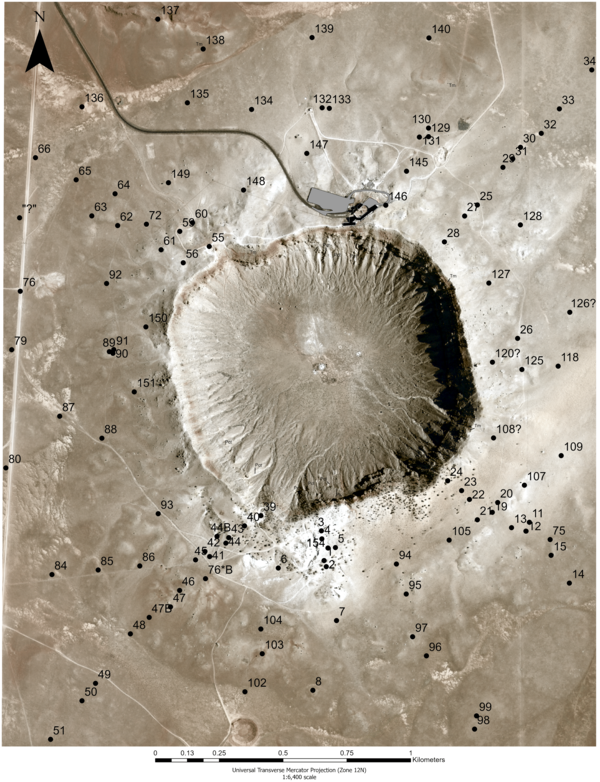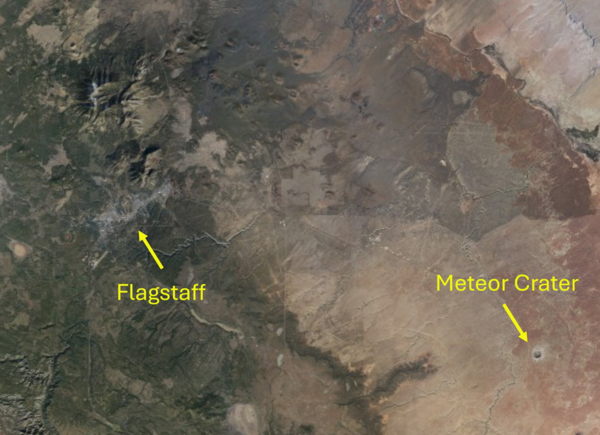NASA's Mars rover Curiosity acquired this image using its Front Hazard Avoidance Camera (Front Hazcam) on Feb. 23, 2025 — sol 4462, or Martian day 4,462 of the Mars Science Laboratory mission — at 21:43:37 UTC.
Multimedia
Welcome to the Astrogeology Multimedia Gallery. Browse here for some of our available imagery, educational videos, and audios. We may get permission to use some non-USGS images and these should be marked and are subject to copyright laws. USGS Astrogeology images can be freely downloaded.
Images
NASA's Mars rover Curiosity acquired this image using its Front Hazard Avoidance Camera (Front Hazcam) on Feb. 23, 2025 — sol 4462, or Martian day 4,462 of the Mars Science Laboratory mission — at 21:43:37 UTC.
This picture of an astronaut investigating a rock on the Moon is on USGS circular 1507. The photo triggers the imagination of finding and taking advantage of resources on the Moon, to further space travel and/or work toward human goals to live beyond Earth.
This picture of an astronaut investigating a rock on the Moon is on USGS circular 1507. The photo triggers the imagination of finding and taking advantage of resources on the Moon, to further space travel and/or work toward human goals to live beyond Earth.
This picture of an astronaut investigating a rock on the Moon is on USGS circular 1507. The photo triggers the imagination of finding and taking advantage of resources on the Moon, to further space travel and/or work toward human goals to live beyond Earth.
This picture of an astronaut investigating a rock on the Moon is on USGS circular 1507. The photo triggers the imagination of finding and taking advantage of resources on the Moon, to further space travel and/or work toward human goals to live beyond Earth.

Aerial image of Meteor Crater with drill hole annotations
Aerial image of Meteor Crater with drill hole annotationsAerial image showing a plan view of Meteor Crater. Drill hole locations denoted by black dots and labeled with their respective drill hole numbers.
Aerial image of Meteor Crater with drill hole annotations
Aerial image of Meteor Crater with drill hole annotationsAerial image showing a plan view of Meteor Crater. Drill hole locations denoted by black dots and labeled with their respective drill hole numbers.

View from the floor of Meteor Crater, looking roughly to the east.
View from the floor of Meteor Crater, looking roughly to the east.Photograph taken from the floor of Meteor Crater, looking roughly east. The crater rim is visible running across the top of the image.
View from the floor of Meteor Crater, looking roughly to the east.
View from the floor of Meteor Crater, looking roughly to the east.Photograph taken from the floor of Meteor Crater, looking roughly east. The crater rim is visible running across the top of the image.
Aerial imagery showing the location of Flagstaff, Arizona and Meteor Crater. Arrows point to Flagstaff on the left and Meteor Crater on the right.
Aerial imagery showing the location of Flagstaff, Arizona and Meteor Crater. Arrows point to Flagstaff on the left and Meteor Crater on the right.
Videos
 Demo showing how to create unit polygons using the PGM toolbox
Demo showing how to create unit polygons using the PGM toolbox
Creating and editing Geologic Units using the PGM Toolbox
Creating and editing Geologic Units using the PGM ToolboxIn this demonstration video, you will learn how to create and update geologic unit polygons using the PGM Toolbox Build Polygons tool. The PGM toolbox is online.
Creating and editing Geologic Units using the PGM Toolbox
Creating and editing Geologic Units using the PGM ToolboxIn this demonstration video, you will learn how to create and update geologic unit polygons using the PGM Toolbox Build Polygons tool. The PGM toolbox is online.
 Thumbnail image for a video showing a computer simulation of two planets colliding and being disrupted.
Thumbnail image for a video showing a computer simulation of two planets colliding and being disrupted.
Computer simulation of two planets undergoing a disruptive giant impact. Disruptive collisions are not expected to be common in Solar System formation and due to numerical effects, the amount of disruption shown here is likely overestimated. The larger (target) body is one tenth the mass of the Earth and the smaller (impactor) body is 70% the mass of the target.
Computer simulation of two planets undergoing a disruptive giant impact. Disruptive collisions are not expected to be common in Solar System formation and due to numerical effects, the amount of disruption shown here is likely overestimated. The larger (target) body is one tenth the mass of the Earth and the smaller (impactor) body is 70% the mass of the target.
 Thumbnail image for a video showing a computer simulation of two planets colliding but not merging.
Thumbnail image for a video showing a computer simulation of two planets colliding but not merging.
Computer simulation of two planets undergoing a hit-and-run giant impact. This style of collision comprises around half of the giant impacts expected to occur during the latter stages of Solar System formation. The larger (target) body is one tenth the mass of the Earth and the smaller (impactor) body is 70% the mass of the target.
Computer simulation of two planets undergoing a hit-and-run giant impact. This style of collision comprises around half of the giant impacts expected to occur during the latter stages of Solar System formation. The larger (target) body is one tenth the mass of the Earth and the smaller (impactor) body is 70% the mass of the target.
 Thumbnail image for a video showing a computer simulation of two planets colliding and merging.
Thumbnail image for a video showing a computer simulation of two planets colliding and merging.
Computer simulation of two planets undergoing a giant impact that results in a merger (accretion). The larger (target) body is one tenth the mass of the Earth and the smaller (impactor) body is 70% the mass of the target. The planets are colliding at 1.08 times their mutual escape velocity, which equates to 3.63 km/s.
Computer simulation of two planets undergoing a giant impact that results in a merger (accretion). The larger (target) body is one tenth the mass of the Earth and the smaller (impactor) body is 70% the mass of the target. The planets are colliding at 1.08 times their mutual escape velocity, which equates to 3.63 km/s.
 Simulated view of Valles Marineris, Mars showing areas with CTX topography
Simulated view of Valles Marineris, Mars showing areas with CTX topography
Flying Over Valles Marineris, Mars with Analysis-Ready Data
Flying Over Valles Marineris, Mars with Analysis-Ready DataFlyover of Valles Marineris, the "Grand Canyon" of Mars, highlighting two analysis-ready datasets provided by USGS. The canyon is more than 4,000 km (2,500 miles) long and up to 7 km (23,000 ft) deep.
Flying Over Valles Marineris, Mars with Analysis-Ready Data
Flying Over Valles Marineris, Mars with Analysis-Ready DataFlyover of Valles Marineris, the "Grand Canyon" of Mars, highlighting two analysis-ready datasets provided by USGS. The canyon is more than 4,000 km (2,500 miles) long and up to 7 km (23,000 ft) deep.
In this demo, you will learn how to create a custom projection in ArcGIS Pro, using data that is not located on Earth. For this example, we will use the Lunar Reconnaissance Orbiter (LRO) Wide Angle Camera (WAC) mosaic of the Moon, and create custom polar and equatorial projections.
In this demo, you will learn how to create a custom projection in ArcGIS Pro, using data that is not located on Earth. For this example, we will use the Lunar Reconnaissance Orbiter (LRO) Wide Angle Camera (WAC) mosaic of the Moon, and create custom polar and equatorial projections.
Audio
My name is Kristen Bennett. I'm at the Astrogeology Science Center and I've been there since 2018.
My name is Kristen Bennett. I'm at the Astrogeology Science Center and I've been there since 2018.
I'm Lauren Edgar. I'm a research geologist at the USGS astrogeology Science Center here in Flagstaff AZ
I'm Lauren Edgar. I'm a research geologist at the USGS astrogeology Science Center here in Flagstaff AZ







